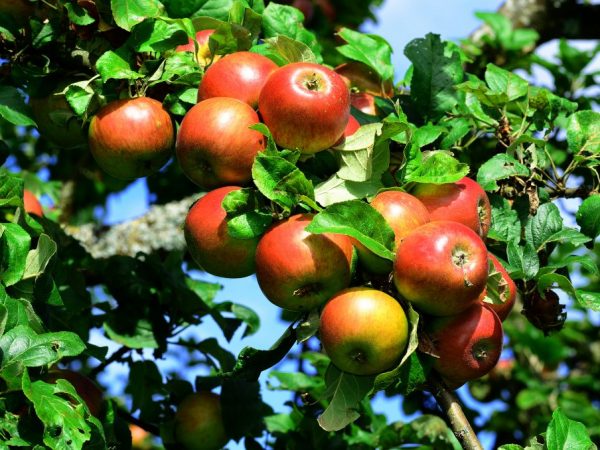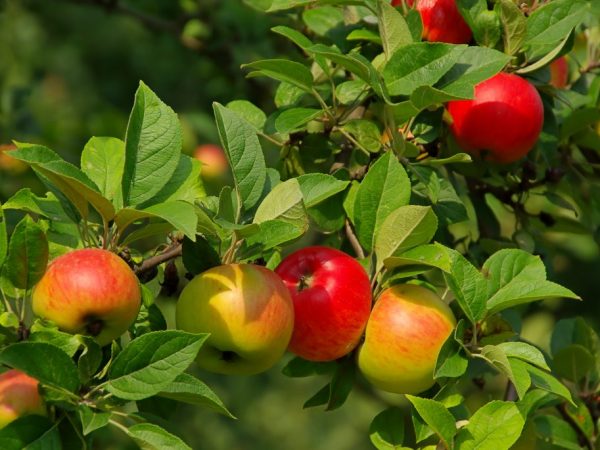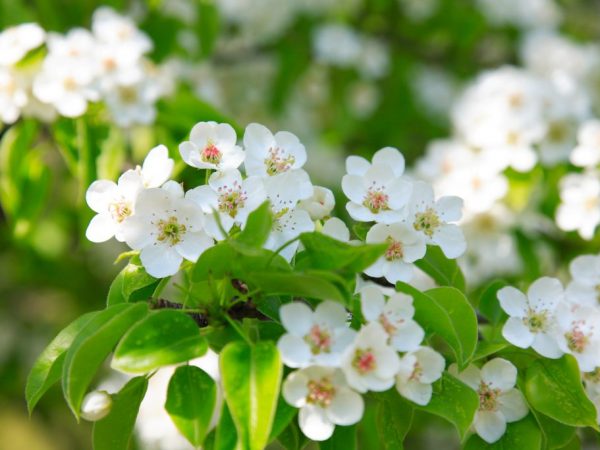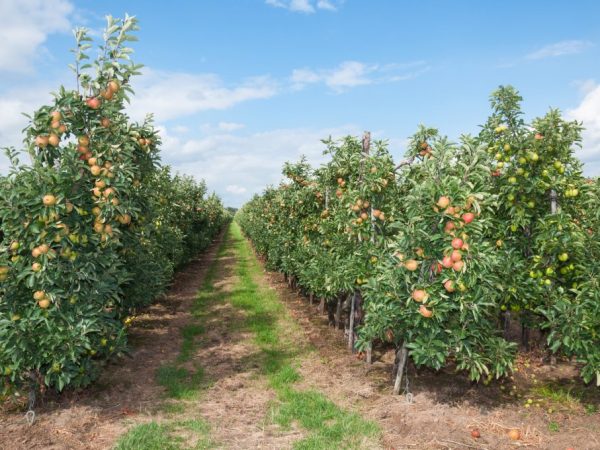Apple-tree varieties Cherry
In modern gardening, the Cherry apple tree takes pride of place - it is a winter variety with a compact crown and high yield rates. The culture is unpretentious to care for, so even a novice gardener can grow it.

Apple-tree varieties Cherry
Features of the variety
An early winter hybrid was obtained by crossing two varieties - Antonovka and Pepin Shafranny.
Thanks to this combination, the plant received the best qualities of its progenitors:
- stable fruiting every year and good keeping quality of fruits (Pepin Saffron);
- high productivity and resistance to scab (Antonovka).
This hybrid is best suited for growing in the regions of the Central Strip and the Black Earth Region. It is most widespread in the Tambov and Voronezh regions.
Wood
The plant is of medium vigor - at mature age it reaches 4-5 m in height. The crown is round or flat-round. The bark on the trunk and shoots is smooth, thick, cherry color. Shoots are erect, develop rapidly and form a thickened crown.
The leaves are dark green with a smooth surface, lanceolate, contain small notches along the edge. The plant blooms with small pale pink flowers, emitting a pleasant floral aroma. In warm and sunny summers, flowering is lush and abundant.
Fruit
One cherry apple weighs about 120-130 g and has a rounded shape. The skin is of medium density, smooth with a light waxy bloom.
Fruit color is yellow-green with a reddish blush.
In the southern regions, where there is an abundance of sunshine and warmth, the fruits take on a rich red color.
The thin skin contains a white, juicy pulp with a sweet and sour taste. The subcutaneous points are large and numerous.
Yield indicators
The yield is stable and high, with good care it is 140 kg of fruits from one adult plant.
The indicators are growing every year, especially with good care and balanced nutrition of the tree.
Early maturity
According to the description, early maturity is average, since the first fruits appear only 5-6 years after planting the seedling.
Disease and cold resistance

The variety has good immunity.
The plant does not have good winter hardiness, in severe winters there is a high risk of freezing of young growth and fruit buds.
Partial freezing is also noted during the period of spring frosts.
It easily tolerates a drop in temperature to -27 °; at lower temperatures, many organs freeze out. Therefore, in Siberia, the Moscow region, in the Altai and the Urals, it needs a good shelter.
Disease resistance is high - the plant has good immunity against scab. Even in the rainy season, the risk of this disease is minimal.
Pollinators
The best pollinating varieties:
- Antonovka ordinary;
- North Sinap;
- Pepin Saffron.
Variety
The columnar apple tree is one of the most popular varieties of the Cherry variety. It has a compact crown, enters the fruiting phase early (at 3 years) and does not require much space in the garden.
The plant forms the first flower buds already in the second year after planting. In adulthood, it reaches no more than 2.5 m in height, forming short young growths. If the tree is not pruned, in a few years it will acquire a pyramidal shape with a diameter of 70-80 cm.
This variety is more suitable for cultivation in the southern zone, in the regions of the Middle and Central zone it needs good shelter.
Landing features
For the regions of the Middle and Central strip, autumn planting of seedlings will be preferable, so that the plants have time to take root and adapt in a new habitat.
In the south, the apple tree is planted in the spring. Seedlings with a closed root system can also be planted in summer, providing them with regular watering and shading from the scorching sun.
Site and soil selection

Apple needs sunlight
Cherry blossoms like to grow in a sunny place where there are no winds and stagnant water. Therefore, choose a flat area with slightly acidic soil, well fertilized with organic and mineral components.
For autumn planting, the soil is harvested 3-4 weeks before the planned procedure.
The plot is sprinkled with horse or cow manure from last year's harvest - 1 bucket per m². Add 1 kg of wood ash, 50 g of superphosphate and the same amount of potassium salt. Then carry out digging and leveling of the site.
In spring planting, nutrients are introduced into the planting pit. To do this, use the same composition as when planting in the fall. The nutrient mixture is mixed with garden soil.
Landing technique
Pits are pulled out, the depth of which should correspond to the length of the root system. The optimum width of the planting holes is 0.5 m.
A metal or wooden stake is installed at the bottom to support the seedling. Then the root system is deepened so that the root collar is on the surface of the soil.
The roots are sprinkled with soil, tamped, watered - 20 liters of water are poured under one plant.
The seedling is tied to a peg with twine, and after all the moisture has gone into the ground, it is mulched with peat or garden soil.
Care requirements
The cherry apple variety needs timely and competent care, especially in the first years of life:
- Watering. To ensure good survival and rapid growth, young trees need to be watered regularly - as the earthen coma dries up and at least five times throughout the season. The first moistening is carried out at the beginning of spring, then two weeks before flowering and two weeks after it. Also, seedlings are watered during the formation of fruit ovaries and in late autumn - to increase frost resistance.
- After each watering, the soil is loosened, removing weeds and plant residues. These manipulations help to protect the tree from drying out and the appearance of diseases, parasites.
- To retain moisture in the soil, after each watering, the near-trunk zone is mulched with garden soil, forming a small mound - 5-7 cm high.
- Top dressing. After planting, the seedlings do not need to be fed - there will be enough nutrients for another 2 years. Starting from the 3rd year of life, apple trees are fertilized with complex preparations that include organic and mineral components. In early spring, nitrogen-containing preparations are introduced into the near-stem zone, before and after flowering superphosphate and potassium salt. A week before the expected autumn cold weather, trees are fed with complex fertilizers with a low nitrogen content.
- Pruning and shaping the crown for this plant are mandatory, given that the cherry tree quickly grows young growth and the crown becomes thickened. Its thinning is carried out in early spring - before the beginning of the process of sap flow or in late autumn - after leaf fall.Pruning is combined with a sanitary haircut - all branches damaged by frost, winds and diseases are cut out. To avoid infection, all sections are covered with garden pitch.
- Preparation for wintering. Young seedlings do not have such immunity as adult trees, therefore, before the onset of the first autumn frosts, they are covered. First, the near-trunk zone is mulched, then covered with spruce branches, sawdust or fallen leaves, after the snow falls, they are covered with a snowdrift. In such conditions, the risk of tree freezing is reduced to zero.
- Prevention of diseases and pests. In the absence of good nutrition, regular watering in the garden, where there are solid thickets of weeds, the apple tree can get sick with powdery mildew, cytosporosis and other types of viral and fungal infections. Therefore, it is important to optimize the care and carry out preventive treatments of the crown and soil with copper-containing preparations - copper sulfate or Bordeaux mixture. For parasites, they are used as folk remedies (garlic, tobacco infusion, ash-soap solution), and pesticides - Aktellik, Aktaru, Fundazol.
Ripening and fruiting

Pollinators will improve fruiting
Good yield indicators are observed in those specimens, next to which their pollinators grow. They bloom at the same time (in May) and thus attract a large number of bees.
Ovaries are formed on short and long branches. Fruiting begins at 5-6 years, stable and annual.
Harvesting and storage
Full ripening of fruits occurs at the beginning of September. In a rainy summer, they ripen a little later - in the middle or at the end of September. The ripeness of apples occurs 2-3 weeks after picking.
The harvest of the Vishnevoe variety has good keeping quality - apples do not lose their marketability and taste until the end of February. Fruits can be easily transported over long distances.
You can store fruits in different ways:
- in apartment conditions - on a glazed balcony or loggia;
- in a basement or cellar with a temperature in the range of 1-3 °;
- in the refrigerator by placing it in the compartment for storing fruits and vegetables.
Helpful hints
- Trees that are partially frozen over the winter can be reanimated. It is necessary to remove all frozen organs, cover it with garden varnish, then feed the tree with ammonium nitrate solution or nitrophosphate (1 tbsp. L. Substance per bucket of water).
- To keep the harvested for a long time, you need to pack each apple in paper, or lay in layers, shifting each layer with hay or cardboard. The harvested crop should be taken out to a cool place.
- In the fall, the tree trunk is whitewashed to protect it from all kinds of parasites in the winter and from sunburn in the spring.
- Sometimes, even if all the rules of care are followed, the tree stands still, and over time it begins to wither and dry. In this case, gardeners recommend one simple trick - to dig out the trunk and drive a thick nail into the area of the root collar. As practice shows, this old method works and helps to restore the vital activity of the tree.
Gardeners reviews
Apple-tree Vishnevoe has gained great popularity among gardeners as a versatile, disease-resistant and unpretentious variety.
High yields and good survival rates in different regions of the country are the main qualities for which these plants have come to be appreciated in industrial horticulture.
Other benefits:
- large-fruited, excellent taste and good marketability of apples;
- resistance to many fungal and viral diseases, including scab;
- the possibility of consuming fruits in winter.
Among the disadvantages are weak winter hardiness and the impossibility of consumption in the spring.

